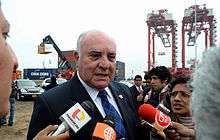Luis Giampietri
Luis Alejandro Giampietri Rojas (born 31 December 1940) is a retired admiral of the Peruvian Navy and a politician with the Peruvian Aprista Party. Giampietri ran successfully as Alan García's first running mate in the 2006 Peruvian election, and was sworn in on 28 July 2006 and served until 28 July 2011.[1]
Luis Giampietri | |
|---|---|
.jpg) | |
| First Vice President of Peru | |
| In office 28 July 2006 – 28 July 2011 | |
| President | Alan García |
| Preceded by | Raúl Diez Canseco |
| Succeeded by | Marisol Espinoza |
| Member of Congress | |
| In office 26 July 2006 – 26 July 2011 | |
| Constituency | Callao |
| Lima City Councilman | |
| In office 1 January 1996 – 1 January 1999 | |
| Personal details | |
| Born | Luis Alejandro Giampietri Rojas 31 December 1940 Callao, Peru |
| Political party | Independent |
| Other political affiliations | Peruvian Aprista Party (2006-2011) |
| Spouse(s) | Lidia Marcela Ramos Seminario |
| Alma mater | Peruvian Naval School |
Giampietri was one of the naval officers implicated in the massacre on El Frontón, a prison island off the coast of Callao.[2] The massacre took place during Alan García's administration, on June 18, 1986, after Shining Path prisoners staged an uprising at El Frontón and two other prisons. All the prisoners involved in the rebellion were killed, and Human Rights Watch claimed that evidence suggested that "no fewer than ninety" of the prisoners killed were victims of extrajudicial executions.[3][4]

On December 17, 1996, Giampietri was taken hostage by the Túpac Amaru Revolutionary Movement (MRTA) during the Japanese embassy hostage crisis. Key to the success of the rescue operation was the intelligence provided by Giampietri, admiral of the Peruvian Navy at the time and former commander of a special operations group. He received and distributed hundreds of bugged items in the building and himself communicated by radio with the Peruvian military.
As of February 2007 Giampietri is working ahead of the CEAN or Extraordinary Commission for APEC, in Spanish initials. He has successfully arranged 127 international meetings so far. These meetings will be held in nine different major cities such as Lima (Peru's capital), Arequipa, Trujillo, Chiclayo, Iquitos, Piura, and Tumbes; and possibly Cusco.
References
- "Presidentes y vicepresidentes desde 1980 en Perú, crisis y realidades". 26 July 2018.
- (in Spanish) Truth and Reconciliation Commission. Las ejecuciones extrajudiciales en el penal de El Frontón y Lurigancho (1986).
- "World Prison Massacres". Human Rights Watch. Archived from the original on February 6, 2008.
- Weschler, Joanna (1993). The Human Rights Watch global report on prisons. Human Rights Watch. p. 93. ISBN 1-56432-101-0.
| Wikimedia Commons has media related to Luis Giampietri. |